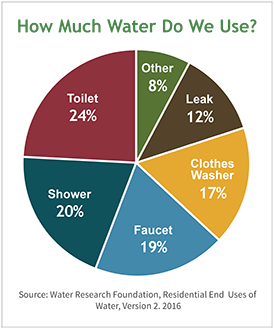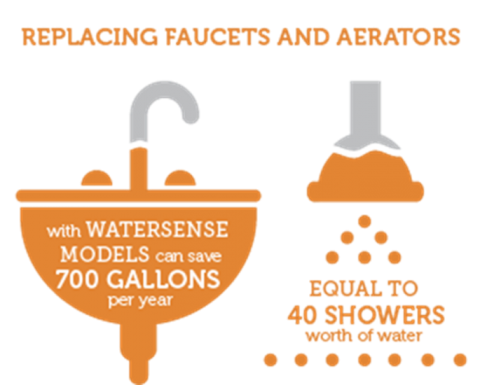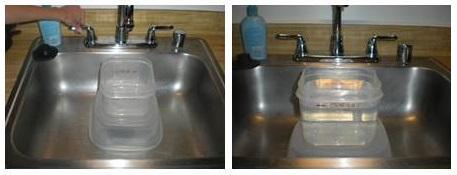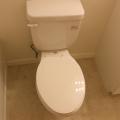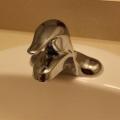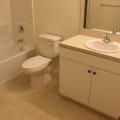Scope
All kitchen faucet manufacturers are required by law to mark their products with the maximum flow rate.
For homes seeking certification under EPA's WaterSense program:
All kitchen sink faucets shall comply with federal standards for a maximum flow rate of 2.2 gallons per minute (gpm) (8.3 lpm). A flow test does not exceed 0.4 gal.
See the Compliance Tab for links to related codes and standards and voluntary federal energy-efficiency program requirements.
Description
Bathroom sink and kitchen sink faucets account for approximately 15.7 percent of indoor residential water use in the United States, or about 1.1 trillion gallons of water used each year across the country. The Energy Policy Act of 1992 originally set the maximum flow rate for both lavatory and kitchen faucets at 2.5 gpm at 80 psi static pressure. In 1994, ASME A112.18.1M-1994–Plumbing Supply Fittings set the maximum flow rate for lavatory (bathroom) faucets at 2.2 gpm at 60 psi. In response to industry requests for conformity with a single standard, in 1998, the U.S. Energy Department adopted the 2.2 gpm at 60 psi maximum flow rate standard for all faucets (both kitchen and bathroom). Other than this maximum flow rate standard, there currently are no universally accepted performance tests or specifications (i.e., rinsing or wetting performance standards) for faucets.
For homes seeking certification under EPA's WaterSense program, installing kitchen sink faucets that are rated for a maximum flow rate of 2.2 gallons per minute (gpm) may contribute to the 30% efficiency requirements under specific WACMs (WaterSense Approved Certification Methods). Although WaterSense does not currently label kitchen faucets, a kitchen faucet or faucet accessory marked as a 2.2-gpm fixture can contribute to the 30% efficiency requirement.
Kitchen Sink Faucets are an Optional Measure for the EPA WaterSense Program
Since there is not a WaterSense label available for kitchen sink faucets, this specification relies on the current national standard for kitchen sink faucets--a maximum flow rate of 2.2 gpm (8.3 lpm) when tested at 60 psi (414kPa). There are many kitchen sink faucets available with maximum flow rates significantly less than 2.2 gpm (8.3 lpm). When installing these lower flow models, contractors must be mindful of the difference in use and user expectations between bathroom sink and kitchen faucets. The major drawback of reduced maximum flow rates for all faucets is increased wait times for hot water and the filling of pots or containers. Kitchen sinks are more commonly used for filling containers, and increased wait times might not be tolerated in the kitchen.
Third party verifiers will obtain a list of the make and model numbers for all bathroom sink faucets and faucet accessories installed in the home and verify that they have earned the WaterSense® label. The verifier will also check the maximum flow rate from all bathroom sink faucets and kitchen sink faucets to ensure that the aerators have not been tampered with or removed. To conduct the test, the verifier will use a small bucket under or attach a flow-measuring bag to the faucet spout, turn on the water completely while starting a stopwatch and, after 10 seconds, turn off the water and check the volume of water collected. The volume of water should be 0.25 gallons or less for bathroom sinks and 0.4 gallons or less for kitchen sink faucets.
These criteria apply to all kitchen sink faucets including bar sinks. These criteria do not apply to pot-filling faucets, utility sink faucets, and laundry sinks.
All faucets and attachable accessories are required by the ASME/CSA performance standard to be marked with their maximum flow rate. Checking the faucet marking will indicate if a bathroom sink faucet meets the EPA WaterSense maximum flow rate, but not the minimum flow rate. To determine if the product meets all aspects of the WaterSense specification, look for the WaterSense label on the product packaging and documentation (the specification requires these materials to bear the Watersense label).
As with bathroom sink faucets, kitchen faucet manufacturers are required by law to mark their products with the maximum flow rate. Any faucet or faucet accessory marked as a 2.2 gpm fixture meets the requirements of this specification.
The WaterSense website also provides a listing of labeled faucets and accessories here.
Success
Install kitchen faucets marked as 2.2-gpm fixtures.
Climate
No climate specific information applies.
Training
Compliance
Retrofit
For more information. see the U.S. Department of Energy's Standard Work Specifications regarding Water Use Reduction.
More
More Info.
Access to some references may require purchase from the publisher. While we continually update our database, links may have changed since posting. Please contact our webmaster if you find broken links.
The following authors and organizations contributed to the content in this Guide.
Sales
Low Flow Fixtures =
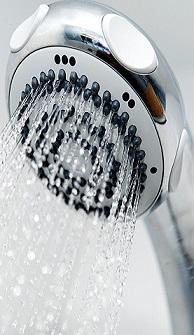
Water-conserving fixtures reduce water usage and the amount of energy needed to heat that water. Faucets and showerheads are designed to save water but provide the same experience as typical fixtures. The WaterSense label (from the U.S. Environmental Protection Agency) takes the guesswork out of choosing the right fixture.
